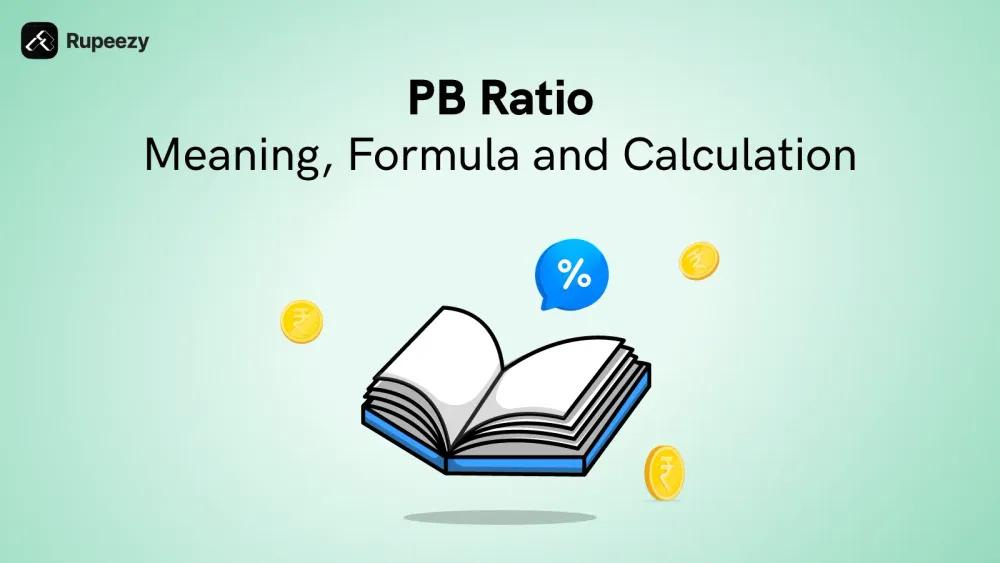PB Ratio – Price to Book Ratio Meaning and Ideal Number


00:00 / 00:00
When it comes to evaluating a stock’s true worth, investors rely on various financial ratios to gain insights into a company’s valuation. Among these, the Price-to-Book (PB) ratio is a key metric for assessing valuation. Whether you're trying to identify undervalued opportunities or assess a firm’s financial foundation, understanding the PB ratio is essential, especially for mature and asset-heavy companies. In this article, we will understand the PB ratio meaning, how to calculate it, its interpretation, and what is considered a good PB ratio number. So let’s dive in!
What is PB Ratio in Share Market?
The PB ratio, also known as the price-to-book value ratio, is the financial metric used by investors to evaluate the relative valuation of the company’s shares. This metric compares the market value of a company’s stock relative to its book value and helps the investor interpret whether the company is undervalued or overvalued. Furthermore, it helps an investor understand how much the market participants are willing to pay for each rupee of the company’s net asset value (i.e, Total assets- Total Liabilities).
How to Calculate PB Ratio
Here is the formula for the PB ratio and an example showing its step-by-step calculation:
PB Ratio Formula:
To calculate the PB ratio, one needs to divide the current market price of the company’s share by its book value per share. That is:
PB Ratio = Market price per share / Book value per share
Here:
Book Value per Share = (Total Assets - Total Liabilities) / Total Outstanding Shares
Total Assets = Everything the company owns (cash, property, machinery, etc.)
Total Liabilities = Everything the company owes (loans, expenses, etc.)
Outstanding Shares = The total number of shares currently held by all shareholders
Example for Calculating PB Ratio
Let’s consider a company with the following financial details:
Total Assets = Rs 12 lakhs
Total Liabilities = Rs 5 lakhs
Outstanding Shares = 7,000
Current Market Price per Share = Rs 120 (scenario 1)
Current Market Price per Share = Rs 80 (scenario 2)
Let us now use this information to calculate the Book Value per Share and the Price-to-Book (P/B) Ratio:
Step 1: Calculate the Book Value of the Company:
Book Value = Total Assets- Total Liabilities
Book Value = Rs 12 lakhs ? Rs. 5 lakhs
= Rs 7 lakhs
Step 2: Calculate Book Value per Share:
Book Value per Share = Book Value / Total Outstanding Shares
Book Value per Share = Rs. 7 lakh/ 7,000
= Rs 100 per share
Step 3: Calculate the P/B Ratio:
If the Current market price per Share is Rs 120
PB Ratio = Market price per share / Book value per share
PB Ratio = Rs 120/Rs 100
= 1.2 times
If the Current market price per Share is Rs 80
PB Ratio = Market price per share / Book value per share
PB Ratio = Rs 80/Rs 100
=0.8 times
Now that we know how to calculate the P/B ratio, let’s make sense of what those numbers actually mean in real life. What does it tell us when a company has a P/B ratio of 1.2 times or 0.8 times? Let’s break it down.
Interpretation of PB Ratio
P/B Ratio < 1.0 time: A PB ratio below 1 often suggests that a stock is undervalued, as it is trading for less than the company's net asset value. However, this could also signal deeper issues such as poor performance, financial instability, or weak investor confidence. So, while it may seem like a bargain, investors should further interpret the company's financials to get a clearer picture.
P/B Ratio > 1.0 time: A PB ratio above 1 typically indicates that a stock is overvalued, as the market is pricing it higher than its book value. Although this may reflect strong earnings, brand reputation, or optimistic future expectations. However, it has to be noted that if this is not backed by fundamentals, a high P/B ratio could point to excessive market hype or overconfidence.
Furthermore, the price-to-book ratio is more suitable for interpreting mature companies and especially asset-heavy companies (e.g., manufacturing, industrials). On the other hand, the reliability of this ratio is reduced in companies that are asset-light (IT companies) since most of their value is tied to their intangible assets, which are not recorded on a company’s books until the occurrence of an event
What is a Good PB Ratio
A PB ratio below 1 is often seen as an undervalued opportunity, suggesting the stock is trading for less than its net assets. However, this is only attractive if the company has strong financials and no underlying issues.
Furthermore, while a P/B ratio above 1 may indicate overvaluation, this overvaluation can be market confidence, strong earnings potential, or brand value, but it should be backed by fundamentals.
Advantages of the PB Ratio
Helps Identify Investment Opportunities: The PB ratio allows the investor to find stocks trading below their book value. Fundamentally good stocks trading below their book value may offer investors future returns through capital appreciation.
Assesses a Company’s Financial Strength: By evaluating how the market values a company's net assets, the PB ratio helps investors gauge the overall health and credibility of its financial position. This makes it a very handy tool when used alongside other financial data and metrics.
Compares Companies Within the Same Industry: The Price-to-Book (P/B) ratio enables investors to compare companies operating within the same industry. This helps the investors to identify companies that are trading at a premium or discount relative to their peers.
Limitations of the PB Ratio
Does Not Account for Future Growth: The PB ratio is based purely on historical figures and does not reflect a company’s future earnings potential. This makes it less effective when evaluating growth-oriented businesses, where anticipated performance plays a major role in determining value.
Excludes Intangible Assets: This metric overlooks valuable intangible assets such as brand equity, intellectual property, and proprietary technology. In industries where such assets are critical, the PB ratio may significantly undervalue a company’s true worth, providing an incomplete financial picture.
Not Suitable for Asset-Light Sectors: For sectors like technology and services, where companies typically hold fewer tangible assets, the P/B ratio becomes less relevant. In these cases, relying solely on this metric can lead to misleading assessments.
PE vs PB ratio
Here are the key differences between the PE and PB ratios to help understand how each is used in evaluating a stock.
Aspect | PE Ratio (Price-to-Earnings) | PB Ratio (Price-to-Book) |
Formula | Market Price per Share / Earnings per Share (EPS) | Market Price per Share / Book Value per Share |
Focus | Measures how much investors are willing to pay for current earnings | Measures how much investors are willing to pay for net assets |
Usefulness | Suitable for evaluating profitability and growth potential | Suitable for assessing asset value and financial stability |
Inclusion of Intangibles | Captures the value of intangibles through earnings | Ignores intangibles like brand and intellectual property |
Conclusion
The Price-to-Book (PB) ratio is a useful metric that helps investors understand the relationship between a company’s assets, liabilities, and its current market value. It is particularly helpful in identifying potentially undervalued stocks, evaluating a company’s financial strength, and comparing peers within the same industry.
However, like any financial ratio, the PB ratio has its limitations and should not be used in isolation. For a well-rounded analysis, it is best interpreted alongside the company’s overall financial performance and other key valuation metrics.
Check Out These Related Articles |
The content on this blog is for educational purposes only and should not be considered investment advice. While we strive for accuracy, some information may contain errors or delays in updates.
Mentions of stocks or investment products are solely for informational purposes and do not constitute recommendations. Investors should conduct their own research before making any decisions.
Investing in financial markets are subject to market risks, and past performance does not guarantee future results. It is advisable to consult a qualified financial professional, review official documents, and verify information independently before making investment decisions.
Open Rupeezy account now. It is free and 100% secure.
Start Stock InvestmentAll Category









